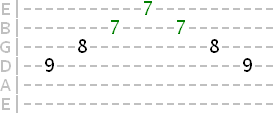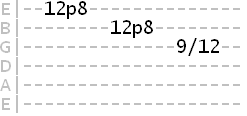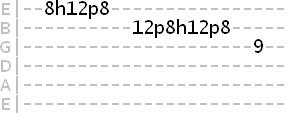Home
> Lead
> Arpeggio
Technique
There are also essential lead techniques you should be confident with for playing arpeggios at higher speeds, such as string skipping and finger rolling.
All the arpeggio techniques in this lesson will be covered in more depth in their own individual lessons, but hopefully by the end of this page you'll be more aware of the many different playing skills you can apply to your arpeggios.
How? By playing one note with the tip of your finger and the next note with the pad of your finger (or vice versa if you're descending the arpeggio pattern). To do this you need to work on collapsing and raising your top finger joints.
Let's say we wanted to play two consecutive notes, from the G to B string. Here's how we would roll using the index finger...
Many arpeggio patterns involve two "vertical" notes like this, in varying positions, so you need to ensure all your fingers can execute this rolling technique.
Use the below exercise to practice this technique using all four fingers, starting with your index finger as pictured above. The tab shows the down strokes and up strokes
and up strokes  we'd use to negotiate these note pairings.
we'd use to negotiate these note pairings.
And here we can see the rolling technique is required to execute a major arpeggio pattern...
Rolling is especially important for sweep picking, as it's the only way you'll be able to play vertical notes like this at faster speeds.
Alternate picking isn't the quickest, most efficient guitar arpeggio technique, but it's fine for styles where speed isn't such a big deal (i.e. if you're just playing quarter and eighth notes most of the time).
A lot of guitarists choose alternate picking for consistency and control.
Here's an example of how string skipping gives us a quick and efficient fingering for a major arpeggio...
Notice how we skip over the B string. And something similar for a minor arpeggio (remember, there's only one semitone difference between a major and minor arpeggio - major 3rd vs minor 3rd)...
Try the below Cmaj7 arpeggio pattern using hammer ons to ascend...
And a slightly different pattern, using pull offs to descend with a slide ( / ) to the resting note at the end...
Using hammer ons and pull offs together...
We can also use this technique to create a fast repeating arpeggio phrase as follows...
Sweep picking involves playing two or more consecutive notes using a single picking direction in one smooth motion.
Guitar Tricks has an in depth video series on sweep picking, taking you from the absolute basics through to advanced applications.
Guitar Arpeggio Technique - How to Play Arpeggios
This lesson on guitar arpeggio technique is all about the physical application of arpeggios on guitar. There are several ways you can play arpeggios - alternate picking, legato (hammer ons and pull offs), sweep picking and tapping.There are also essential lead techniques you should be confident with for playing arpeggios at higher speeds, such as string skipping and finger rolling.
All the arpeggio techniques in this lesson will be covered in more depth in their own individual lessons, but hopefully by the end of this page you'll be more aware of the many different playing skills you can apply to your arpeggios.
The arpeggio rolling technique
Rolling is a technique that allows you to play two vertical notes, on the same fret, in quick succession, using just one finger.How? By playing one note with the tip of your finger and the next note with the pad of your finger (or vice versa if you're descending the arpeggio pattern). To do this you need to work on collapsing and raising your top finger joints.
Let's say we wanted to play two consecutive notes, from the G to B string. Here's how we would roll using the index finger...
On the G
(lower) string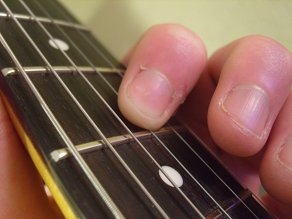 Start by fretting the lower string as usual, with the lower tip of the finger. |
On the B
(higher) string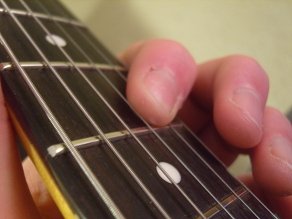 The finger collapses or "rolls" back to a flatter position, fretting the string above and muting the string below. |
Many arpeggio patterns involve two "vertical" notes like this, in varying positions, so you need to ensure all your fingers can execute this rolling technique.
Use the below exercise to practice this technique using all four fingers, starting with your index finger as pictured above. The tab shows the down strokes
 and up strokes
and up strokes  we'd use to negotiate these note pairings.
we'd use to negotiate these note pairings.And here we can see the rolling technique is required to execute a major arpeggio pattern...
Rolling is especially important for sweep picking, as it's the only way you'll be able to play vertical notes like this at faster speeds.
Alternate picking arpeggios
A lot of great guitarists use strict alternate picking for both scales and arpeggios.Alternate picking isn't the quickest, most efficient guitar arpeggio technique, but it's fine for styles where speed isn't such a big deal (i.e. if you're just playing quarter and eighth notes most of the time).
A lot of guitarists choose alternate picking for consistency and control.
String skipping arpeggios
String skipping allows you to play wide note intervals more economically.Here's an example of how string skipping gives us a quick and efficient fingering for a major arpeggio...
Notice how we skip over the B string. And something similar for a minor arpeggio (remember, there's only one semitone difference between a major and minor arpeggio - major 3rd vs minor 3rd)...
Legato arpeggio technique
Using hammer ons and pull offs (known as legato - playing without picking) is another way of playing arpeggios faster and more economically, since we're not picking every note.Try the below Cmaj7 arpeggio pattern using hammer ons to ascend...
And a slightly different pattern, using pull offs to descend with a slide ( / ) to the resting note at the end...
Using hammer ons and pull offs together...
We can also use this technique to create a fast repeating arpeggio phrase as follows...
Sweep picking arpeggios
A more advanced and difficult way to play arpeggios, but unmatched for speed when using a pick.Sweep picking involves playing two or more consecutive notes using a single picking direction in one smooth motion.
Guitar Tricks has an in depth video series on sweep picking, taking you from the absolute basics through to advanced applications.
| |
Tweet |
Stay updated and learn more
Sign up to the newsletter for updates and grab your free Uncommon Chords book
Sign up to the newsletter for updates and grab your free Uncommon Chords book
More Lead Guitar Lessons






